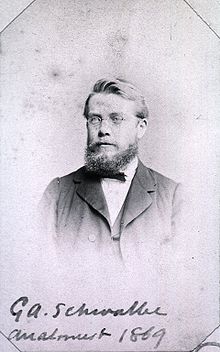Gustav Albert Schwalbe
This article includes a improve this article by introducing more precise citations. (May 2020) ) |

Gustav Albert Schwalbe, M.D. (1 August 1844 – 23 April 1916) was a German
anatomist and anthropologist from Quedlinburg
.
He was educated at the universities of
University of Leipzig, and then professor of anatomy successively at the universities of Jena (1873), Königsberg (1881), and Strassburg (1883) — at that time a German university, Alsace
having been annexed to Germany. There he died.
Known for his anthropological research of primitive man, Schwalbe considered the
Pithecantropus Erectus
).
In 1869 Schwalbe injected
vestibular nucleus; "Schwalbe's ring", which is a circular ridge consisting of collagenous fibers surrounding the outer margin of Descemet's membrane; and "Schwalbe's line", an anatomical line located on the posterior surface of the eye's cornea. He was the first to describe Paneth cells in the Archiv für mikroskopische Anatomie in 1872; he described them 16 years before Joseph Paneth. Paneth even acknowledged Schwalbe and used one of his drawings in his article that was published in the same journal.[1]
Literary works
- an editor of the Jahresberichte für Anatomie und Entwicklungsgeschichte.
- an editor of the Zeitschrift für Morphologie und Anthropologie.
- He edited also the second edition of Hoffmann's Lehrbuch der Anatomie des Menschen (Erlangen, 1877–81).
and is the author of:
- Lehrbuch der Neurologie (Textbook of neurology) ib. 1881
- Ueber die Kaliberverhältnisse der Nervenfasern, (About caliber conditions of nerve fibers) Leipzig, 1882
- Lehrbuch der Anatomie der Sinnesorgane (Textbook on the anatomy of sensory organs), Erlangen, 1886
- Studien über Pithecantropus Erectus (Study of Pithecantropus Erectus), Leipzig, 1899
- Der Neander Schädel (The Neanderthal skull) ib. 1901
- Vorgeschichte der Menschen (Prehistory of humans) ib. 1903.
References
- ^ Wehkamp J, Stange EF. Paneth’s disease. J Crohns Colitis. 2010;4:523–531 https://academic.oup.com/ecco-jcc/article/4/5/523/2366438?login=true
 This article incorporates text from a publication now in the public domain: Singer, Isidore; et al., eds. (1901–1906). "Gustav Schwalbe". The Jewish Encyclopedia. New York: Funk & Wagnalls.
This article incorporates text from a publication now in the public domain: Singer, Isidore; et al., eds. (1901–1906). "Gustav Schwalbe". The Jewish Encyclopedia. New York: Funk & Wagnalls.- Mondofacto Dictionary (definition of eponyms)[permanent dead link]
- Neanderthal Meets Modern Man Archived 2007-06-08 at the Wayback Machine
- Cerebrospinal Fluid Research Archived 2007-06-30 at the Wayback Machine Integration of the subarachnoid space and lymphatics
External links
- "Gustav Schwalbe." In Online Biographical Dictionary of the History of Paleoanthropology. Edited by Matthew R. Goodrum. (2016) available at https://drive.google.com/file/d/12w1bxrUYqTXYgRf1ko6lbH7HnTTu115w/view
- Works by Gustav Albert Schwalbe at Project Gutenberg
- Works by or about Gustav Albert Schwalbe at Internet Archive
